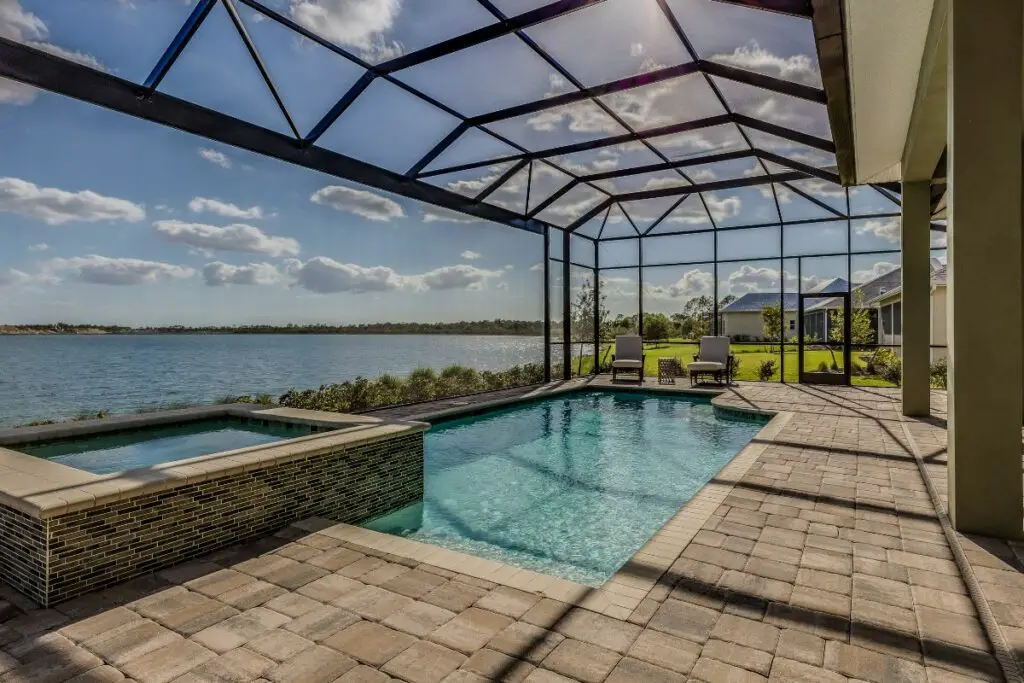Pools in Florida often have cages around them for several reasons.
One of the main reasons is to keep out unwanted wildlife, such as alligators and snakes, which are common in Florida. The cages also provide a barrier to keep children and pets safe while still allowing the pool to be visible from inside the house.
Additionally, the cages help to keep debris, such as leaves and branches, out of the pool which reduces maintenance. They also protect the pool from high winds and storms.

Overall, the cages serve as a practical and important safety feature for Florida pool owners.
Table of Contents
What are Florida’s Pool Screen Laws?
Florida has specific laws and building codes regarding pool screens and enclosures. According to Florida Building Code, residential swimming pools must have a barrier that completely surrounds the pool and prevent unsupervised access by young children.
The barrier must be at least 4 feet high and consist of a fence, wall, or screen enclosure. The barrier must also have a self-closing and self-latching gate, and the latch must be at least 54 inches above the ground or pool deck.
Additionally, the barrier must be designed and constructed to not have any openings that would allow a 4-inch diameter sphere to pass through.
The Florida pool screen laws are put in place to protect young children and to keep unwanted wildlife out of the pool.
Do You Have To Have a Cage Around Your Pool in Florida?
According to Florida Building Code, if you have a residential swimming pool you must have a barrier that completely surrounds the pool and prevent unsupervised access by young children. This barrier can be in form of a fence, wall, or screen enclosure.
However, if the pool is not intended for swimming or if it’s an indoor pool, it doesn’t have to have a barrier.
Also, if the pool is not accessible to young children or is equipped with an approved safety cover, it may not be necessary to have a cage around the pool.
It’s worth mentioning that in some cities or counties in Florida, there might be additional regulations regarding pool barriers, so it’s always a good idea to check with local authorities for any specific requirements before building or installing a pool.
Conclusion
In conclusion, Florida has specific laws and building codes regarding pool screens and enclosures. Residential swimming pools must have a barrier that completely surrounds the pool and prevent unsupervised access by young children.
The barrier must be at least 4 feet high and consist of a fence, wall, or screen enclosure. The barrier must also have a self-closing and self-latching gate, and the latch must be at least 54 inches above the ground or pool deck.
Additionally, the barrier must be designed and constructed to not have any openings that would allow a 4-inch diameter sphere to pass through.
It is important to note that even if a pool is not intended for swimming or if it’s an indoor pool, it doesn’t have to have a barrier.
However, it is always recommended to check with local authorities for any specific requirements before building or installing a pool.
- How to Build a Planter Box for Bamboo: A Step-by-Step Guide

- Can Robotic Lawnmowers Handle Steep Slopes?

- Do You Need a Specific Lawn for a Robotic Lawnmower? Expert Advice

- Are Robotic Lawnmowers Safe for Pets and Children? Safety Features of Robotic Lawnmowers

- Why Use Robotic Lawnmowers? Advantages of Using a Robotic Lawnmower

- Is the GARDENA SILENO City 300 Cordless or Corded? A Clear Answer














